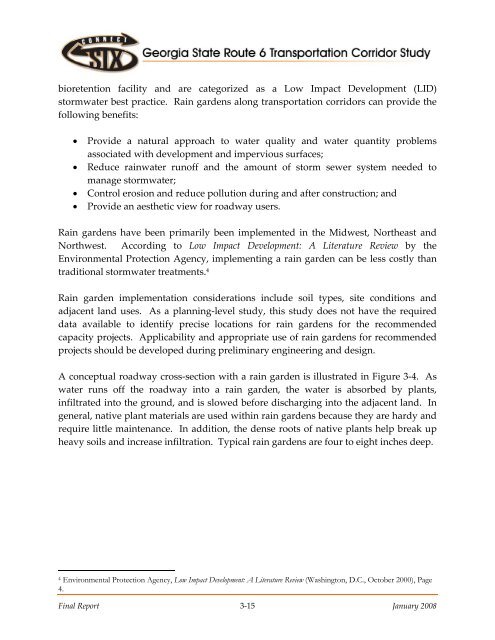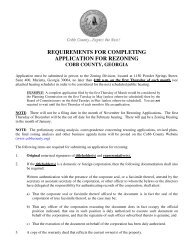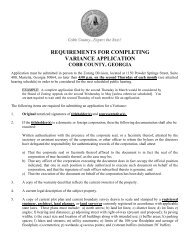State Route 6 Corridor Study Final Report - Cobb County Government
State Route 6 Corridor Study Final Report - Cobb County Government
State Route 6 Corridor Study Final Report - Cobb County Government
You also want an ePaper? Increase the reach of your titles
YUMPU automatically turns print PDFs into web optimized ePapers that Google loves.
ioretention facility and are categorized as a Low Impact Development (LID)<br />
stormwater best practice. Rain gardens along transportation corridors can provide the<br />
following benefits:<br />
• Provide a natural approach to water quality and water quantity problems<br />
associated with development and impervious surfaces;<br />
• Reduce rainwater runoff and the amount of storm sewer system needed to<br />
manage stormwater;<br />
• Control erosion and reduce pollution during and after construction; and<br />
• Provide an aesthetic view for roadway users.<br />
Rain gardens have been primarily been implemented in the Midwest, Northeast and<br />
Northwest. According to Low Impact Development: A Literature Review by the<br />
Environmental Protection Agency, implementing a rain garden can be less costly than<br />
traditional stormwater treatments. 4<br />
Rain garden implementation considerations include soil types, site conditions and<br />
adjacent land uses. As a planning‐level study, this study does not have the required<br />
data available to identify precise locations for rain gardens for the recommended<br />
capacity projects. Applicability and appropriate use of rain gardens for recommended<br />
projects should be developed during preliminary engineering and design.<br />
A conceptual roadway cross‐section with a rain garden is illustrated in Figure 3‐4. As<br />
water runs off the roadway into a rain garden, the water is absorbed by plants,<br />
infiltrated into the ground, and is slowed before discharging into the adjacent land. In<br />
general, native plant materials are used within rain gardens because they are hardy and<br />
require little maintenance. In addition, the dense roots of native plants help break up<br />
heavy soils and increase infiltration. Typical rain gardens are four to eight inches deep.<br />
4 Environmental Protection Agency, Low Impact Development: A Literature Review (Washington, D.C., October 2000), Page<br />
4.<br />
<strong>Final</strong> <strong>Report</strong> 3‐15<br />
January 2008

















